Financial Statement Analysis: Accounting Fundamentals Report for 2019
VerifiedAdded on 2023/01/09
|14
|3756
|76
Report
AI Summary
This report provides a detailed analysis of accounting fundamentals, including the preparation and interpretation of financial statements. It begins with the presentation of an income statement and a statement of financial position for Wales plc, demonstrating the application of accounting principles. The report then delves into a comprehensive ratio analysis for Jerry plc, comparing financial performance for 2018 and 2019. It calculates and interprets key ratios such as Return on Capital Employed (ROCE), Return on Equity (ROE), Earnings per Share (EPS), Gross Profit Margin, Asset Turnover Ratio, Stock Holding Period, Debtors Collection Period, Current Ratio, and Gearing Ratio. The analysis reveals trends, strengths, and weaknesses in Jerry plc's financial health. Furthermore, the report discusses the different user groups of company accounts, explaining their interests in the financial information provided, and evaluates the advantages, disadvantages, and limitations of a highly regulated financial reporting regime from the perspectives of both users and preparers of financial statements.
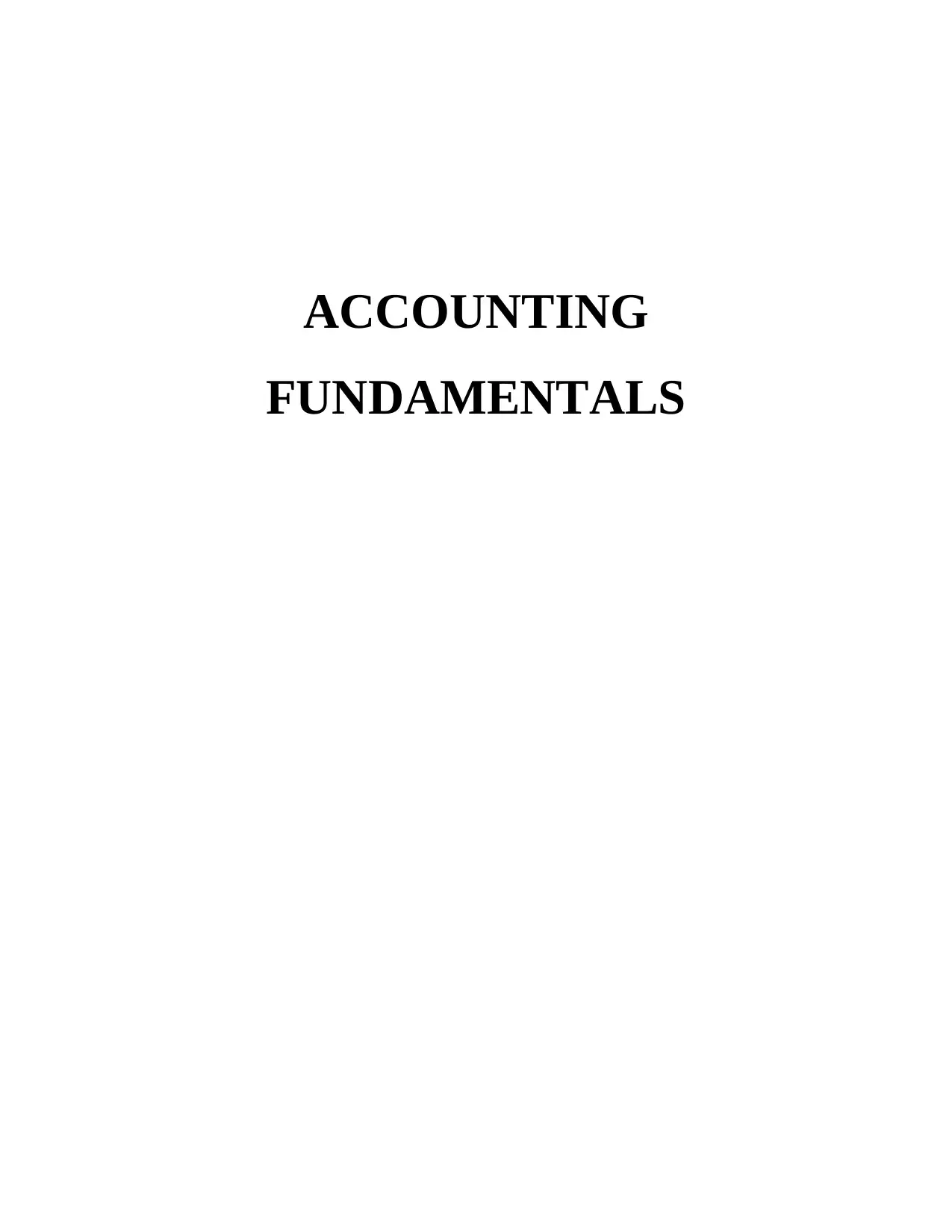
ACCOUNTING
FUNDAMENTALS
FUNDAMENTALS
Paraphrase This Document
Need a fresh take? Get an instant paraphrase of this document with our AI Paraphraser
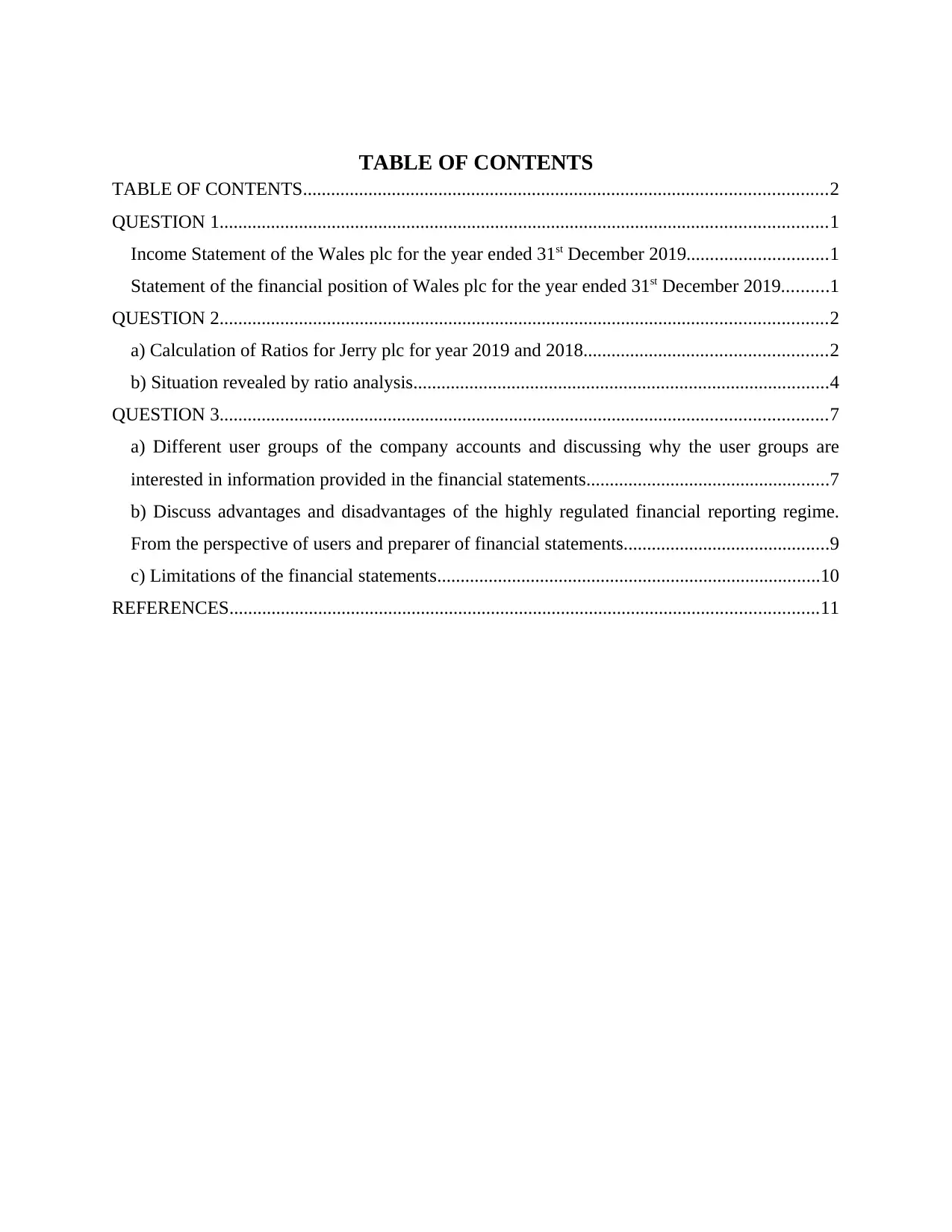
TABLE OF CONTENTS
TABLE OF CONTENTS................................................................................................................2
QUESTION 1..................................................................................................................................1
Income Statement of the Wales plc for the year ended 31st December 2019..............................1
Statement of the financial position of Wales plc for the year ended 31st December 2019..........1
QUESTION 2..................................................................................................................................2
a) Calculation of Ratios for Jerry plc for year 2019 and 2018....................................................2
b) Situation revealed by ratio analysis.........................................................................................4
QUESTION 3..................................................................................................................................7
a) Different user groups of the company accounts and discussing why the user groups are
interested in information provided in the financial statements....................................................7
b) Discuss advantages and disadvantages of the highly regulated financial reporting regime.
From the perspective of users and preparer of financial statements............................................9
c) Limitations of the financial statements..................................................................................10
REFERENCES..............................................................................................................................11
TABLE OF CONTENTS................................................................................................................2
QUESTION 1..................................................................................................................................1
Income Statement of the Wales plc for the year ended 31st December 2019..............................1
Statement of the financial position of Wales plc for the year ended 31st December 2019..........1
QUESTION 2..................................................................................................................................2
a) Calculation of Ratios for Jerry plc for year 2019 and 2018....................................................2
b) Situation revealed by ratio analysis.........................................................................................4
QUESTION 3..................................................................................................................................7
a) Different user groups of the company accounts and discussing why the user groups are
interested in information provided in the financial statements....................................................7
b) Discuss advantages and disadvantages of the highly regulated financial reporting regime.
From the perspective of users and preparer of financial statements............................................9
c) Limitations of the financial statements..................................................................................10
REFERENCES..............................................................................................................................11
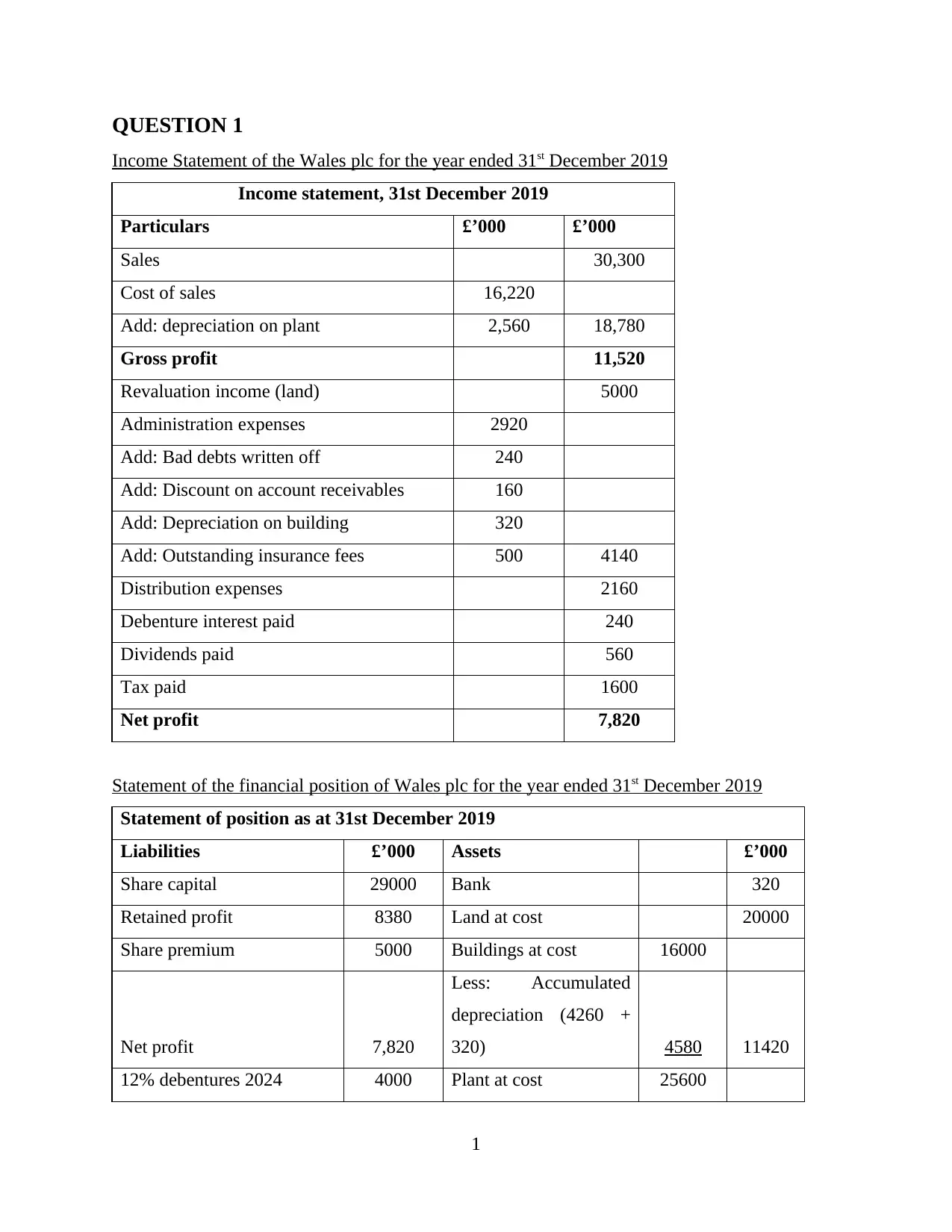
QUESTION 1
Income Statement of the Wales plc for the year ended 31st December 2019
Income statement, 31st December 2019
Particulars £’000 £’000
Sales 30,300
Cost of sales 16,220
Add: depreciation on plant 2,560 18,780
Gross profit 11,520
Revaluation income (land) 5000
Administration expenses 2920
Add: Bad debts written off 240
Add: Discount on account receivables 160
Add: Depreciation on building 320
Add: Outstanding insurance fees 500 4140
Distribution expenses 2160
Debenture interest paid 240
Dividends paid 560
Tax paid 1600
Net profit 7,820
Statement of the financial position of Wales plc for the year ended 31st December 2019
Statement of position as at 31st December 2019
Liabilities £’000 Assets £’000
Share capital 29000 Bank 320
Retained profit 8380 Land at cost 20000
Share premium 5000 Buildings at cost 16000
Net profit 7,820
Less: Accumulated
depreciation (4260 +
320) 4580 11420
12% debentures 2024 4000 Plant at cost 25600
1
Income Statement of the Wales plc for the year ended 31st December 2019
Income statement, 31st December 2019
Particulars £’000 £’000
Sales 30,300
Cost of sales 16,220
Add: depreciation on plant 2,560 18,780
Gross profit 11,520
Revaluation income (land) 5000
Administration expenses 2920
Add: Bad debts written off 240
Add: Discount on account receivables 160
Add: Depreciation on building 320
Add: Outstanding insurance fees 500 4140
Distribution expenses 2160
Debenture interest paid 240
Dividends paid 560
Tax paid 1600
Net profit 7,820
Statement of the financial position of Wales plc for the year ended 31st December 2019
Statement of position as at 31st December 2019
Liabilities £’000 Assets £’000
Share capital 29000 Bank 320
Retained profit 8380 Land at cost 20000
Share premium 5000 Buildings at cost 16000
Net profit 7,820
Less: Accumulated
depreciation (4260 +
320) 4580 11420
12% debentures 2024 4000 Plant at cost 25600
1
⊘ This is a preview!⊘
Do you want full access?
Subscribe today to unlock all pages.

Trusted by 1+ million students worldwide
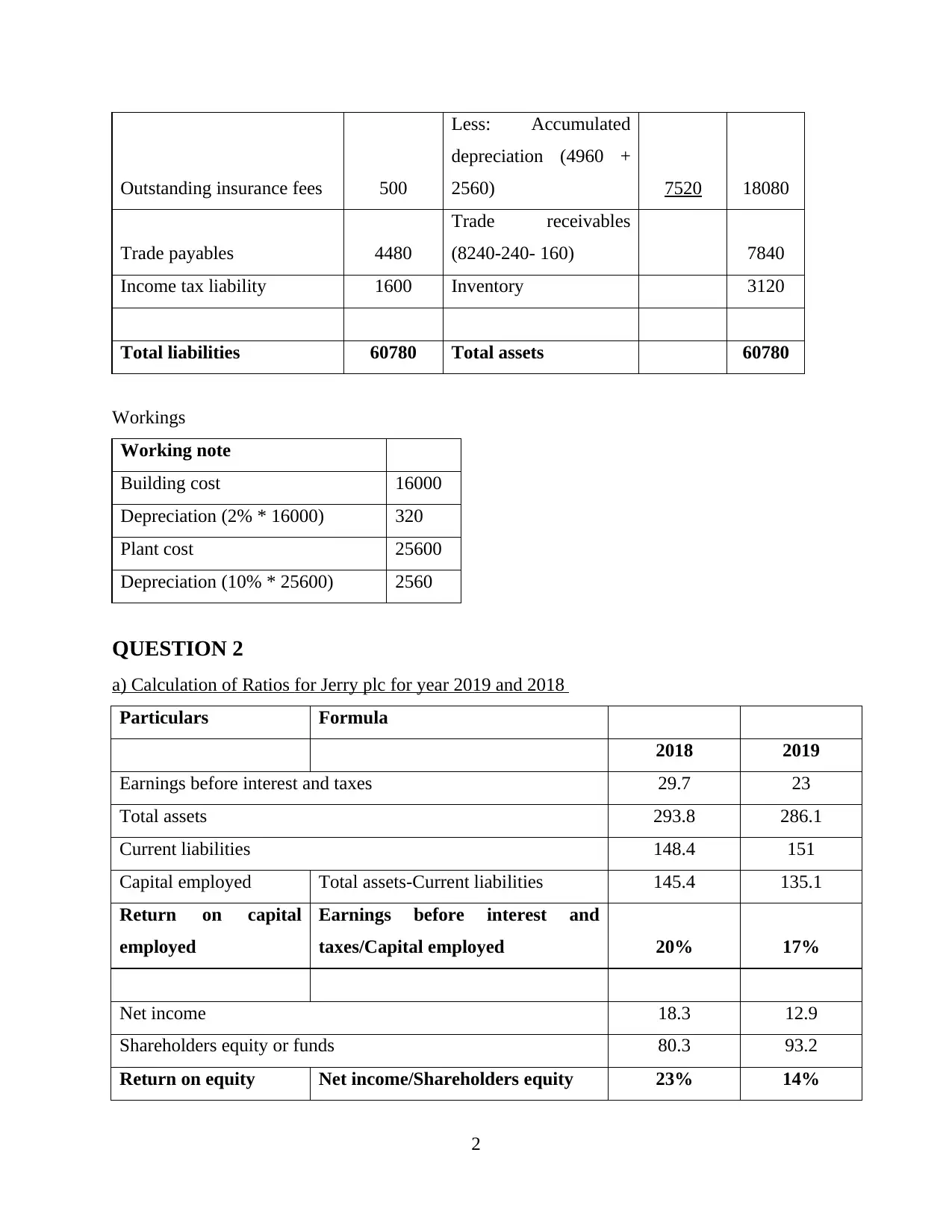
Outstanding insurance fees 500
Less: Accumulated
depreciation (4960 +
2560) 7520 18080
Trade payables 4480
Trade receivables
(8240-240- 160) 7840
Income tax liability 1600 Inventory 3120
Total liabilities 60780 Total assets 60780
Workings
Working note
Building cost 16000
Depreciation (2% * 16000) 320
Plant cost 25600
Depreciation (10% * 25600) 2560
QUESTION 2
a) Calculation of Ratios for Jerry plc for year 2019 and 2018
Particulars Formula
2018 2019
Earnings before interest and taxes 29.7 23
Total assets 293.8 286.1
Current liabilities 148.4 151
Capital employed Total assets-Current liabilities 145.4 135.1
Return on capital
employed
Earnings before interest and
taxes/Capital employed 20% 17%
Net income 18.3 12.9
Shareholders equity or funds 80.3 93.2
Return on equity Net income/Shareholders equity 23% 14%
2
Less: Accumulated
depreciation (4960 +
2560) 7520 18080
Trade payables 4480
Trade receivables
(8240-240- 160) 7840
Income tax liability 1600 Inventory 3120
Total liabilities 60780 Total assets 60780
Workings
Working note
Building cost 16000
Depreciation (2% * 16000) 320
Plant cost 25600
Depreciation (10% * 25600) 2560
QUESTION 2
a) Calculation of Ratios for Jerry plc for year 2019 and 2018
Particulars Formula
2018 2019
Earnings before interest and taxes 29.7 23
Total assets 293.8 286.1
Current liabilities 148.4 151
Capital employed Total assets-Current liabilities 145.4 135.1
Return on capital
employed
Earnings before interest and
taxes/Capital employed 20% 17%
Net income 18.3 12.9
Shareholders equity or funds 80.3 93.2
Return on equity Net income/Shareholders equity 23% 14%
2
Paraphrase This Document
Need a fresh take? Get an instant paraphrase of this document with our AI Paraphraser
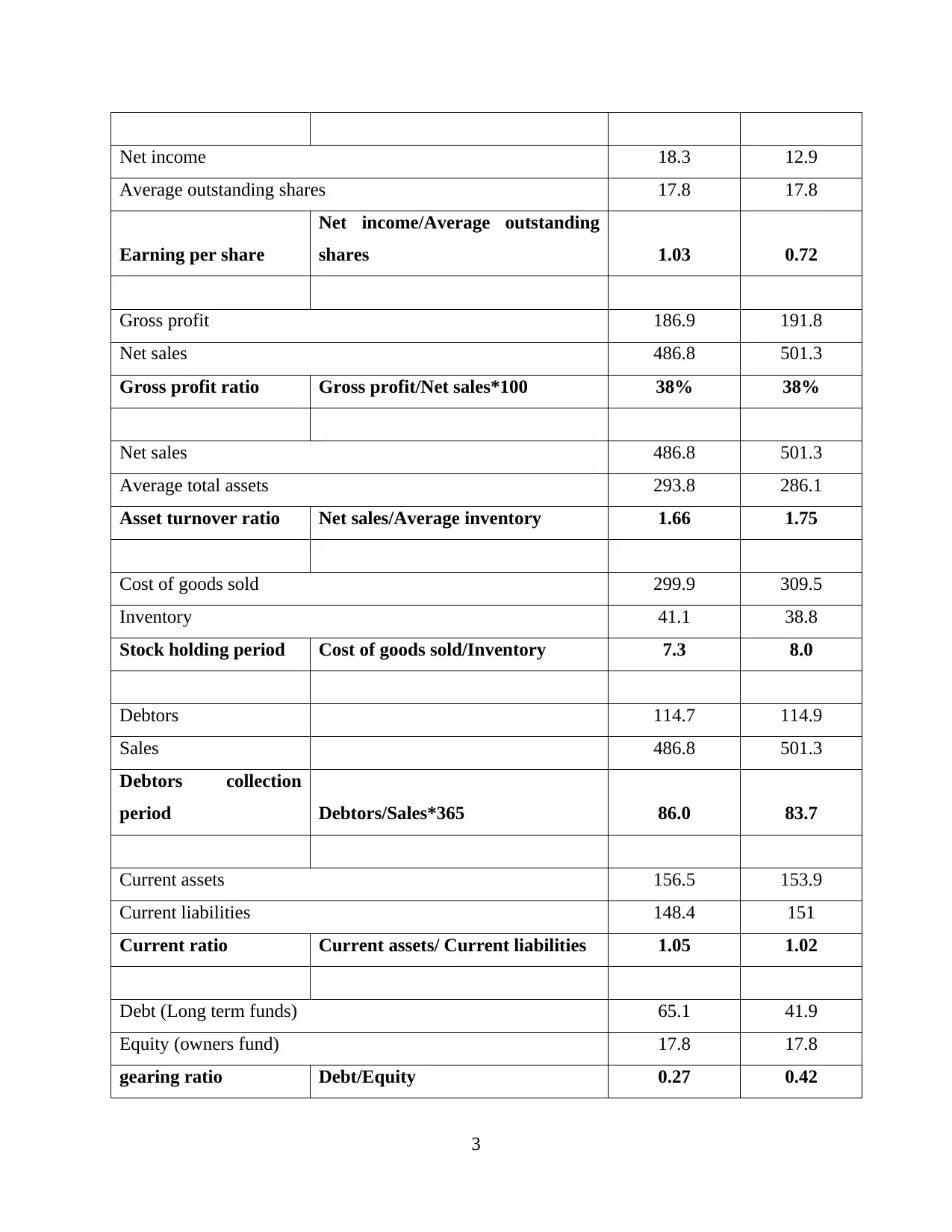
Net income 18.3 12.9
Average outstanding shares 17.8 17.8
Earning per share
Net income/Average outstanding
shares 1.03 0.72
Gross profit 186.9 191.8
Net sales 486.8 501.3
Gross profit ratio Gross profit/Net sales*100 38% 38%
Net sales 486.8 501.3
Average total assets 293.8 286.1
Asset turnover ratio Net sales/Average inventory 1.66 1.75
Cost of goods sold 299.9 309.5
Inventory 41.1 38.8
Stock holding period Cost of goods sold/Inventory 7.3 8.0
Debtors 114.7 114.9
Sales 486.8 501.3
Debtors collection
period Debtors/Sales*365 86.0 83.7
Current assets 156.5 153.9
Current liabilities 148.4 151
Current ratio Current assets/ Current liabilities 1.05 1.02
Debt (Long term funds) 65.1 41.9
Equity (owners fund) 17.8 17.8
gearing ratio Debt/Equity 0.27 0.42
3
Average outstanding shares 17.8 17.8
Earning per share
Net income/Average outstanding
shares 1.03 0.72
Gross profit 186.9 191.8
Net sales 486.8 501.3
Gross profit ratio Gross profit/Net sales*100 38% 38%
Net sales 486.8 501.3
Average total assets 293.8 286.1
Asset turnover ratio Net sales/Average inventory 1.66 1.75
Cost of goods sold 299.9 309.5
Inventory 41.1 38.8
Stock holding period Cost of goods sold/Inventory 7.3 8.0
Debtors 114.7 114.9
Sales 486.8 501.3
Debtors collection
period Debtors/Sales*365 86.0 83.7
Current assets 156.5 153.9
Current liabilities 148.4 151
Current ratio Current assets/ Current liabilities 1.05 1.02
Debt (Long term funds) 65.1 41.9
Equity (owners fund) 17.8 17.8
gearing ratio Debt/Equity 0.27 0.42
3
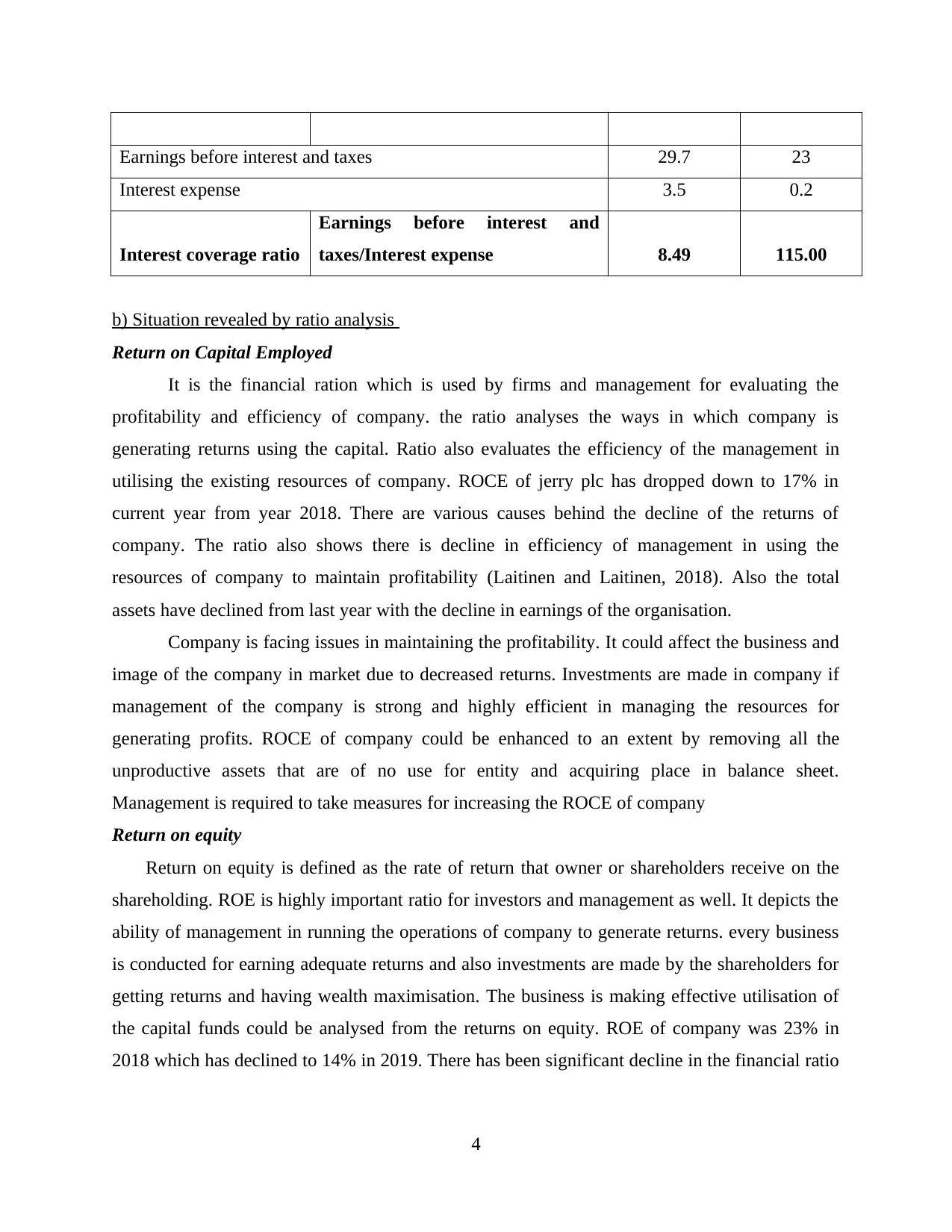
Earnings before interest and taxes 29.7 23
Interest expense 3.5 0.2
Interest coverage ratio
Earnings before interest and
taxes/Interest expense 8.49 115.00
b) Situation revealed by ratio analysis
Return on Capital Employed
It is the financial ration which is used by firms and management for evaluating the
profitability and efficiency of company. the ratio analyses the ways in which company is
generating returns using the capital. Ratio also evaluates the efficiency of the management in
utilising the existing resources of company. ROCE of jerry plc has dropped down to 17% in
current year from year 2018. There are various causes behind the decline of the returns of
company. The ratio also shows there is decline in efficiency of management in using the
resources of company to maintain profitability (Laitinen and Laitinen, 2018). Also the total
assets have declined from last year with the decline in earnings of the organisation.
Company is facing issues in maintaining the profitability. It could affect the business and
image of the company in market due to decreased returns. Investments are made in company if
management of the company is strong and highly efficient in managing the resources for
generating profits. ROCE of company could be enhanced to an extent by removing all the
unproductive assets that are of no use for entity and acquiring place in balance sheet.
Management is required to take measures for increasing the ROCE of company
Return on equity
Return on equity is defined as the rate of return that owner or shareholders receive on the
shareholding. ROE is highly important ratio for investors and management as well. It depicts the
ability of management in running the operations of company to generate returns. every business
is conducted for earning adequate returns and also investments are made by the shareholders for
getting returns and having wealth maximisation. The business is making effective utilisation of
the capital funds could be analysed from the returns on equity. ROE of company was 23% in
2018 which has declined to 14% in 2019. There has been significant decline in the financial ratio
4
Interest expense 3.5 0.2
Interest coverage ratio
Earnings before interest and
taxes/Interest expense 8.49 115.00
b) Situation revealed by ratio analysis
Return on Capital Employed
It is the financial ration which is used by firms and management for evaluating the
profitability and efficiency of company. the ratio analyses the ways in which company is
generating returns using the capital. Ratio also evaluates the efficiency of the management in
utilising the existing resources of company. ROCE of jerry plc has dropped down to 17% in
current year from year 2018. There are various causes behind the decline of the returns of
company. The ratio also shows there is decline in efficiency of management in using the
resources of company to maintain profitability (Laitinen and Laitinen, 2018). Also the total
assets have declined from last year with the decline in earnings of the organisation.
Company is facing issues in maintaining the profitability. It could affect the business and
image of the company in market due to decreased returns. Investments are made in company if
management of the company is strong and highly efficient in managing the resources for
generating profits. ROCE of company could be enhanced to an extent by removing all the
unproductive assets that are of no use for entity and acquiring place in balance sheet.
Management is required to take measures for increasing the ROCE of company
Return on equity
Return on equity is defined as the rate of return that owner or shareholders receive on the
shareholding. ROE is highly important ratio for investors and management as well. It depicts the
ability of management in running the operations of company to generate returns. every business
is conducted for earning adequate returns and also investments are made by the shareholders for
getting returns and having wealth maximisation. The business is making effective utilisation of
the capital funds could be analysed from the returns on equity. ROE of company was 23% in
2018 which has declined to 14% in 2019. There has been significant decline in the financial ratio
4
⊘ This is a preview!⊘
Do you want full access?
Subscribe today to unlock all pages.

Trusted by 1+ million students worldwide
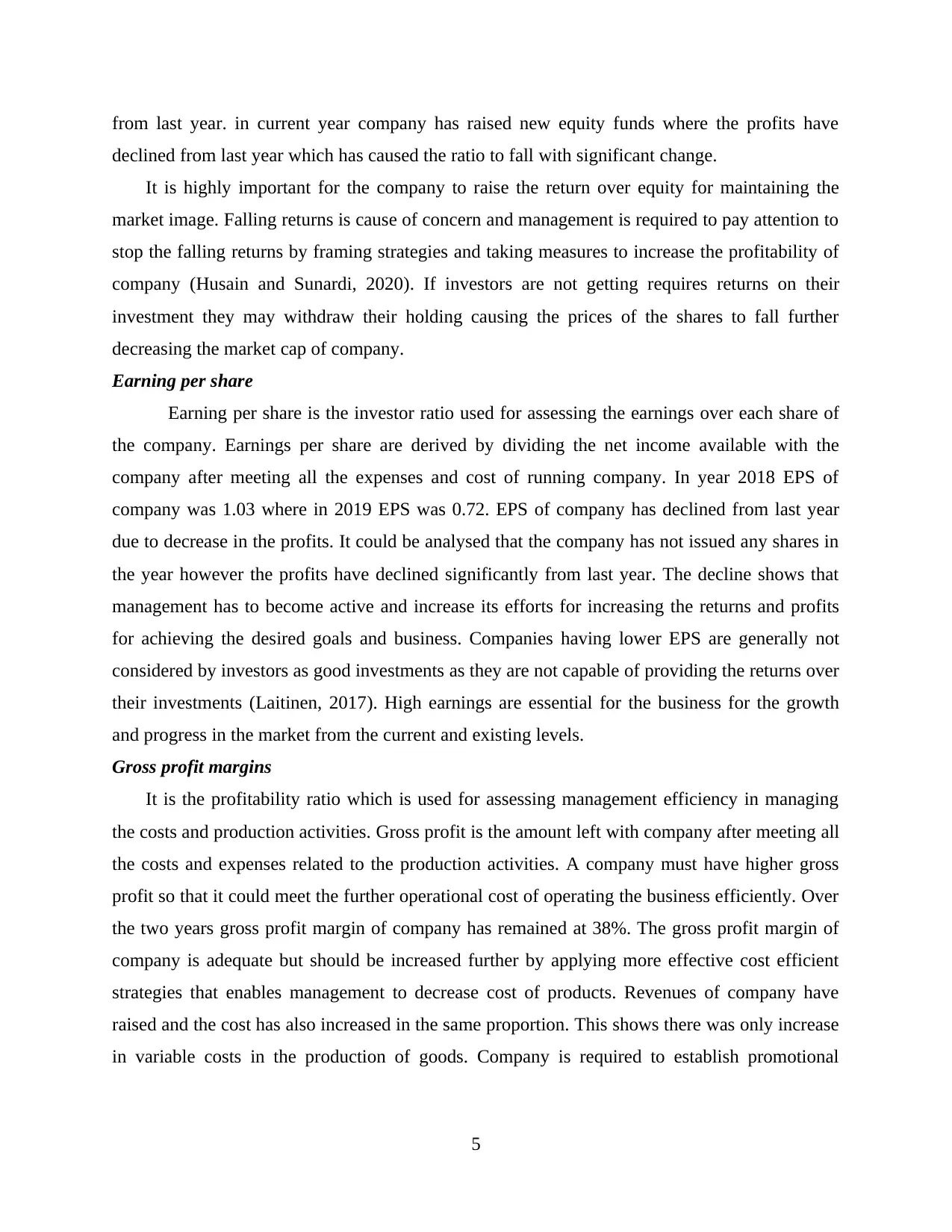
from last year. in current year company has raised new equity funds where the profits have
declined from last year which has caused the ratio to fall with significant change.
It is highly important for the company to raise the return over equity for maintaining the
market image. Falling returns is cause of concern and management is required to pay attention to
stop the falling returns by framing strategies and taking measures to increase the profitability of
company (Husain and Sunardi, 2020). If investors are not getting requires returns on their
investment they may withdraw their holding causing the prices of the shares to fall further
decreasing the market cap of company.
Earning per share
Earning per share is the investor ratio used for assessing the earnings over each share of
the company. Earnings per share are derived by dividing the net income available with the
company after meeting all the expenses and cost of running company. In year 2018 EPS of
company was 1.03 where in 2019 EPS was 0.72. EPS of company has declined from last year
due to decrease in the profits. It could be analysed that the company has not issued any shares in
the year however the profits have declined significantly from last year. The decline shows that
management has to become active and increase its efforts for increasing the returns and profits
for achieving the desired goals and business. Companies having lower EPS are generally not
considered by investors as good investments as they are not capable of providing the returns over
their investments (Laitinen, 2017). High earnings are essential for the business for the growth
and progress in the market from the current and existing levels.
Gross profit margins
It is the profitability ratio which is used for assessing management efficiency in managing
the costs and production activities. Gross profit is the amount left with company after meeting all
the costs and expenses related to the production activities. A company must have higher gross
profit so that it could meet the further operational cost of operating the business efficiently. Over
the two years gross profit margin of company has remained at 38%. The gross profit margin of
company is adequate but should be increased further by applying more effective cost efficient
strategies that enables management to decrease cost of products. Revenues of company have
raised and the cost has also increased in the same proportion. This shows there was only increase
in variable costs in the production of goods. Company is required to establish promotional
5
declined from last year which has caused the ratio to fall with significant change.
It is highly important for the company to raise the return over equity for maintaining the
market image. Falling returns is cause of concern and management is required to pay attention to
stop the falling returns by framing strategies and taking measures to increase the profitability of
company (Husain and Sunardi, 2020). If investors are not getting requires returns on their
investment they may withdraw their holding causing the prices of the shares to fall further
decreasing the market cap of company.
Earning per share
Earning per share is the investor ratio used for assessing the earnings over each share of
the company. Earnings per share are derived by dividing the net income available with the
company after meeting all the expenses and cost of running company. In year 2018 EPS of
company was 1.03 where in 2019 EPS was 0.72. EPS of company has declined from last year
due to decrease in the profits. It could be analysed that the company has not issued any shares in
the year however the profits have declined significantly from last year. The decline shows that
management has to become active and increase its efforts for increasing the returns and profits
for achieving the desired goals and business. Companies having lower EPS are generally not
considered by investors as good investments as they are not capable of providing the returns over
their investments (Laitinen, 2017). High earnings are essential for the business for the growth
and progress in the market from the current and existing levels.
Gross profit margins
It is the profitability ratio which is used for assessing management efficiency in managing
the costs and production activities. Gross profit is the amount left with company after meeting all
the costs and expenses related to the production activities. A company must have higher gross
profit so that it could meet the further operational cost of operating the business efficiently. Over
the two years gross profit margin of company has remained at 38%. The gross profit margin of
company is adequate but should be increased further by applying more effective cost efficient
strategies that enables management to decrease cost of products. Revenues of company have
raised and the cost has also increased in the same proportion. This shows there was only increase
in variable costs in the production of goods. Company is required to establish promotional
5
Paraphrase This Document
Need a fresh take? Get an instant paraphrase of this document with our AI Paraphraser

strategies for increasing the revenues and profits and at the same time maintaining effective
control over cost of operation.
Asset Turnover Ratio
It is ratio used by the users of financial statements for evaluating the ability of company
in generating sales over the assets of company. It reflects the effectiveness of management in
utilising the existing resources and assets of company to generate sales. Company with lower
asset turnover ratio is considered having inefficient management which is not making effective
use of the resources of the entity (Selvam, Dhamotharan and Sankarkumar, 2020). Asset
turnover of company is 1.75 which has increased from 1.66 in last year. The ratio is adequate and
shows that the management of company is efficient and generates sales up to 1.75 times of the
assets. Higher the ratio better is for the company as company will be able to generate more
revenues with the existing assets. Investors are interested in knowing the ratio of the firm as they
require analysing the management of company in which they are proposing to invest funds.
Funds are not invested in companies with weak management as they may not be able to make
effective use of the resources made available to them.
Stock holding period
Stock holding period is also known as inventory turnover ratio. It reflects the average
time that entity is taking to turn the inventory in sales includes inventory in work in progress.
The ratio suggest for low stock holding period ensuring that inventory is held for shorter period
of time. Management must effectively turn the inventory into sales for the business. It shows that
the management of the company is highly efficient in moving the inventory of the business. Jerry
plc is having stock holding period of 8 which was 7.3 in 2018 there has been upward movement
in the ratio (Martins, 2017). It could be analysed from the above ratio that stock holding period
of company is shorter however management is required to decrease it further for becoming more
efficient and generating faster cash for the company. Faster movement enhances the operating
cycle of the business.
Debtors Collection Period
It reflects the time that company takes in collecting the dues from its customers. A
company must have shorter collection period for having adequate cash flow in the company. The
collection period of company is 84 days in 2019 which was 86 days in year 2018. It has
decreased the debtor days from last year. However it is required to further reduce the collection
6
control over cost of operation.
Asset Turnover Ratio
It is ratio used by the users of financial statements for evaluating the ability of company
in generating sales over the assets of company. It reflects the effectiveness of management in
utilising the existing resources and assets of company to generate sales. Company with lower
asset turnover ratio is considered having inefficient management which is not making effective
use of the resources of the entity (Selvam, Dhamotharan and Sankarkumar, 2020). Asset
turnover of company is 1.75 which has increased from 1.66 in last year. The ratio is adequate and
shows that the management of company is efficient and generates sales up to 1.75 times of the
assets. Higher the ratio better is for the company as company will be able to generate more
revenues with the existing assets. Investors are interested in knowing the ratio of the firm as they
require analysing the management of company in which they are proposing to invest funds.
Funds are not invested in companies with weak management as they may not be able to make
effective use of the resources made available to them.
Stock holding period
Stock holding period is also known as inventory turnover ratio. It reflects the average
time that entity is taking to turn the inventory in sales includes inventory in work in progress.
The ratio suggest for low stock holding period ensuring that inventory is held for shorter period
of time. Management must effectively turn the inventory into sales for the business. It shows that
the management of the company is highly efficient in moving the inventory of the business. Jerry
plc is having stock holding period of 8 which was 7.3 in 2018 there has been upward movement
in the ratio (Martins, 2017). It could be analysed from the above ratio that stock holding period
of company is shorter however management is required to decrease it further for becoming more
efficient and generating faster cash for the company. Faster movement enhances the operating
cycle of the business.
Debtors Collection Period
It reflects the time that company takes in collecting the dues from its customers. A
company must have shorter collection period for having adequate cash flow in the company. The
collection period of company is 84 days in 2019 which was 86 days in year 2018. It has
decreased the debtor days from last year. However it is required to further reduce the collection
6

period as the credit given by company is high and is affecting the cash operating cycle
(Buvaneswari, Pushpalatha and Sandesh, 2017). Higher credit periods are generally granted for
increasing the revenues and customer base but this affects the cash cycle and causes higher
demand of money which is then borrowed from the external sources at interests.
Current Ratio
The financial ratio is used for assessing the liquidity of company. Current ratio measures
the ability of company to meet the short term obligations with the available current assets. Every
company must have enough current assets so that it could meet the its obligations and run the
operations successfully. Current ratio of company last year was 1.05 in 2018 where in current
year it is 1.02. Current ratio of company is not strong and states that short term obligations are
equal to the current assets. Managers are required to make liquidity position strong by managing
the current assets and obligations adequately. Lower ratio could reflect negative image to the
creditors of the entity.
Gearing Ratio
The gearing ratio is an important financial ratio which is used by the analysts and
management for evaluating the debt and equity ratio in overall capital of the company. It assesses
the capital structure of the entity. It is also used for assessing the financial risk of the enterprise.
Debt equity ratio of Jerry plc is 0.42 where last year it was 0.27. There has been upward
movement in the ratio that shows company has increased the debt. It will increase the financial
risk associated with the business (Coulon, 2020). Raising debt higher than this will make the
company highly risky. Currently it is having adequate capital structure with minimum cost of
capital as benefits from debt capital are availed from the government. Cost of equity is higher
than debt but the risk involved in equity is very low as company is not under obligation to pay
dividend every year.
Interest Coverage Ratio
It measures the ability of company in making payments for interest expenses. it evaluates
how many times it could pay interest from the existing profits of the business. Interest coverage
ratio of the firm should be higher. The company is having interest coverage ratio of 115 that has
increased significantly from 8.49 last year. The ability to pay interest has increased as interest
expenses of the entity have declined significantly as compared with previous year.
7
(Buvaneswari, Pushpalatha and Sandesh, 2017). Higher credit periods are generally granted for
increasing the revenues and customer base but this affects the cash cycle and causes higher
demand of money which is then borrowed from the external sources at interests.
Current Ratio
The financial ratio is used for assessing the liquidity of company. Current ratio measures
the ability of company to meet the short term obligations with the available current assets. Every
company must have enough current assets so that it could meet the its obligations and run the
operations successfully. Current ratio of company last year was 1.05 in 2018 where in current
year it is 1.02. Current ratio of company is not strong and states that short term obligations are
equal to the current assets. Managers are required to make liquidity position strong by managing
the current assets and obligations adequately. Lower ratio could reflect negative image to the
creditors of the entity.
Gearing Ratio
The gearing ratio is an important financial ratio which is used by the analysts and
management for evaluating the debt and equity ratio in overall capital of the company. It assesses
the capital structure of the entity. It is also used for assessing the financial risk of the enterprise.
Debt equity ratio of Jerry plc is 0.42 where last year it was 0.27. There has been upward
movement in the ratio that shows company has increased the debt. It will increase the financial
risk associated with the business (Coulon, 2020). Raising debt higher than this will make the
company highly risky. Currently it is having adequate capital structure with minimum cost of
capital as benefits from debt capital are availed from the government. Cost of equity is higher
than debt but the risk involved in equity is very low as company is not under obligation to pay
dividend every year.
Interest Coverage Ratio
It measures the ability of company in making payments for interest expenses. it evaluates
how many times it could pay interest from the existing profits of the business. Interest coverage
ratio of the firm should be higher. The company is having interest coverage ratio of 115 that has
increased significantly from 8.49 last year. The ability to pay interest has increased as interest
expenses of the entity have declined significantly as compared with previous year.
7
⊘ This is a preview!⊘
Do you want full access?
Subscribe today to unlock all pages.

Trusted by 1+ million students worldwide
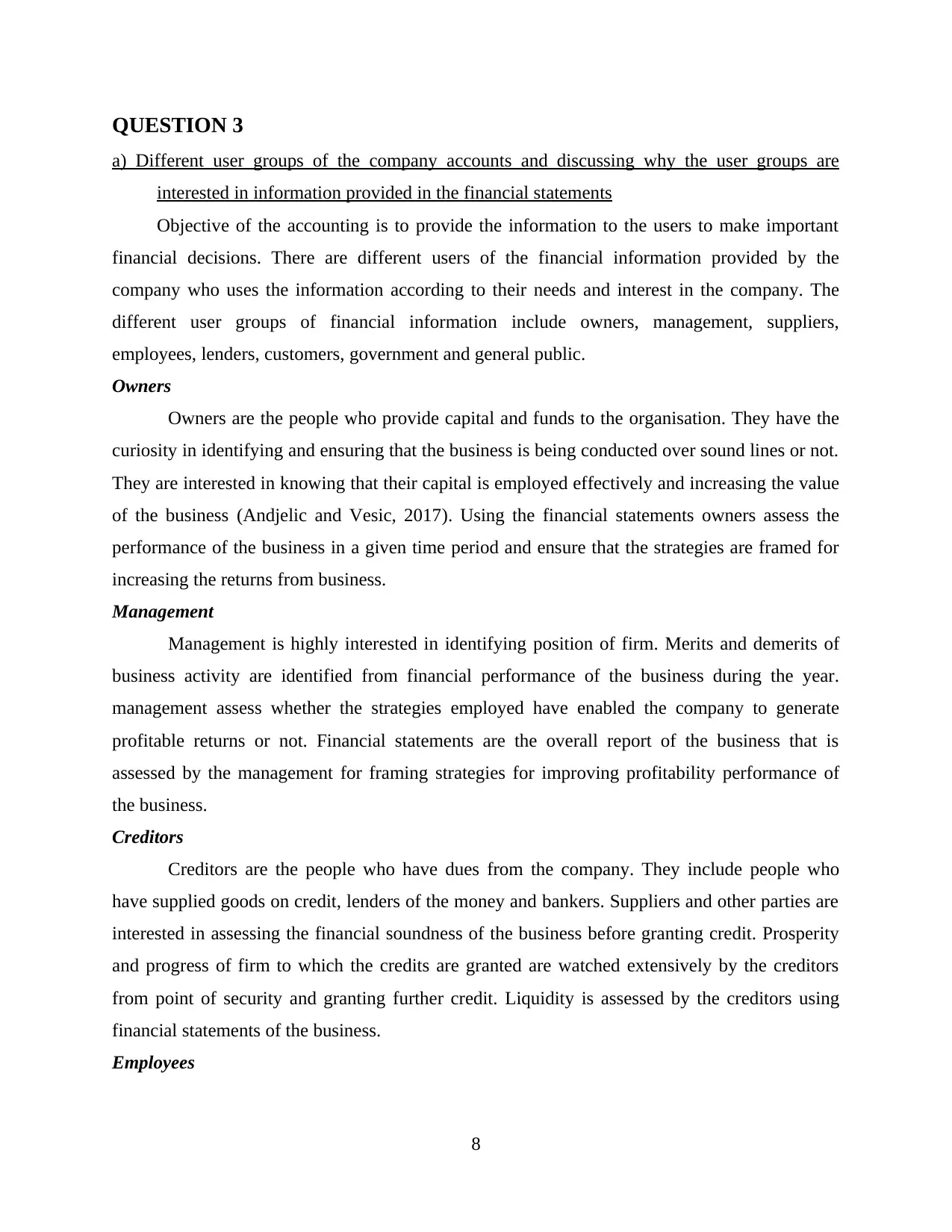
QUESTION 3
a) Different user groups of the company accounts and discussing why the user groups are
interested in information provided in the financial statements
Objective of the accounting is to provide the information to the users to make important
financial decisions. There are different users of the financial information provided by the
company who uses the information according to their needs and interest in the company. The
different user groups of financial information include owners, management, suppliers,
employees, lenders, customers, government and general public.
Owners
Owners are the people who provide capital and funds to the organisation. They have the
curiosity in identifying and ensuring that the business is being conducted over sound lines or not.
They are interested in knowing that their capital is employed effectively and increasing the value
of the business (Andjelic and Vesic, 2017). Using the financial statements owners assess the
performance of the business in a given time period and ensure that the strategies are framed for
increasing the returns from business.
Management
Management is highly interested in identifying position of firm. Merits and demerits of
business activity are identified from financial performance of the business during the year.
management assess whether the strategies employed have enabled the company to generate
profitable returns or not. Financial statements are the overall report of the business that is
assessed by the management for framing strategies for improving profitability performance of
the business.
Creditors
Creditors are the people who have dues from the company. They include people who
have supplied goods on credit, lenders of the money and bankers. Suppliers and other parties are
interested in assessing the financial soundness of the business before granting credit. Prosperity
and progress of firm to which the credits are granted are watched extensively by the creditors
from point of security and granting further credit. Liquidity is assessed by the creditors using
financial statements of the business.
Employees
8
a) Different user groups of the company accounts and discussing why the user groups are
interested in information provided in the financial statements
Objective of the accounting is to provide the information to the users to make important
financial decisions. There are different users of the financial information provided by the
company who uses the information according to their needs and interest in the company. The
different user groups of financial information include owners, management, suppliers,
employees, lenders, customers, government and general public.
Owners
Owners are the people who provide capital and funds to the organisation. They have the
curiosity in identifying and ensuring that the business is being conducted over sound lines or not.
They are interested in knowing that their capital is employed effectively and increasing the value
of the business (Andjelic and Vesic, 2017). Using the financial statements owners assess the
performance of the business in a given time period and ensure that the strategies are framed for
increasing the returns from business.
Management
Management is highly interested in identifying position of firm. Merits and demerits of
business activity are identified from financial performance of the business during the year.
management assess whether the strategies employed have enabled the company to generate
profitable returns or not. Financial statements are the overall report of the business that is
assessed by the management for framing strategies for improving profitability performance of
the business.
Creditors
Creditors are the people who have dues from the company. They include people who
have supplied goods on credit, lenders of the money and bankers. Suppliers and other parties are
interested in assessing the financial soundness of the business before granting credit. Prosperity
and progress of firm to which the credits are granted are watched extensively by the creditors
from point of security and granting further credit. Liquidity is assessed by the creditors using
financial statements of the business.
Employees
8
Paraphrase This Document
Need a fresh take? Get an instant paraphrase of this document with our AI Paraphraser
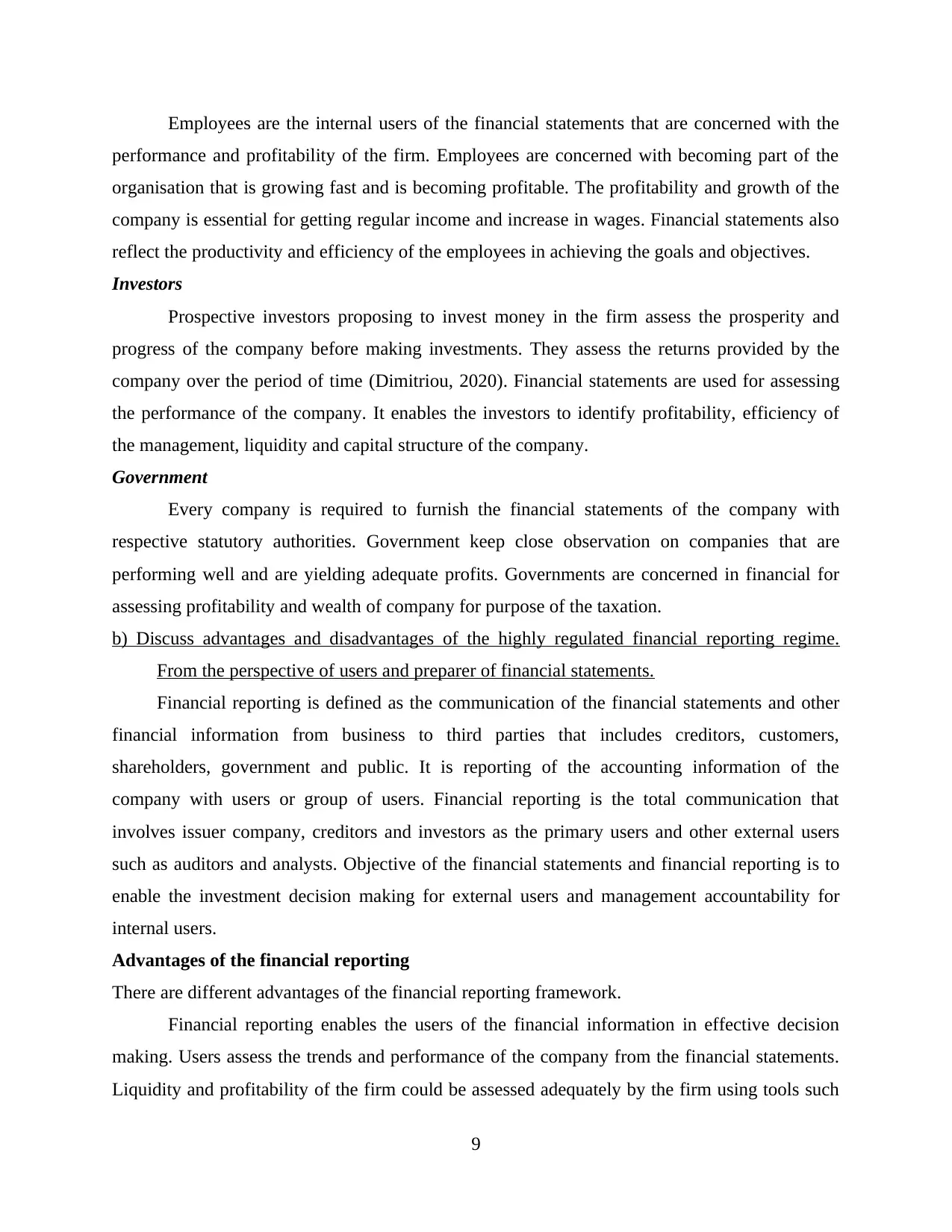
Employees are the internal users of the financial statements that are concerned with the
performance and profitability of the firm. Employees are concerned with becoming part of the
organisation that is growing fast and is becoming profitable. The profitability and growth of the
company is essential for getting regular income and increase in wages. Financial statements also
reflect the productivity and efficiency of the employees in achieving the goals and objectives.
Investors
Prospective investors proposing to invest money in the firm assess the prosperity and
progress of the company before making investments. They assess the returns provided by the
company over the period of time (Dimitriou, 2020). Financial statements are used for assessing
the performance of the company. It enables the investors to identify profitability, efficiency of
the management, liquidity and capital structure of the company.
Government
Every company is required to furnish the financial statements of the company with
respective statutory authorities. Government keep close observation on companies that are
performing well and are yielding adequate profits. Governments are concerned in financial for
assessing profitability and wealth of company for purpose of the taxation.
b) Discuss advantages and disadvantages of the highly regulated financial reporting regime.
From the perspective of users and preparer of financial statements.
Financial reporting is defined as the communication of the financial statements and other
financial information from business to third parties that includes creditors, customers,
shareholders, government and public. It is reporting of the accounting information of the
company with users or group of users. Financial reporting is the total communication that
involves issuer company, creditors and investors as the primary users and other external users
such as auditors and analysts. Objective of the financial statements and financial reporting is to
enable the investment decision making for external users and management accountability for
internal users.
Advantages of the financial reporting
There are different advantages of the financial reporting framework.
Financial reporting enables the users of the financial information in effective decision
making. Users assess the trends and performance of the company from the financial statements.
Liquidity and profitability of the firm could be assessed adequately by the firm using tools such
9
performance and profitability of the firm. Employees are concerned with becoming part of the
organisation that is growing fast and is becoming profitable. The profitability and growth of the
company is essential for getting regular income and increase in wages. Financial statements also
reflect the productivity and efficiency of the employees in achieving the goals and objectives.
Investors
Prospective investors proposing to invest money in the firm assess the prosperity and
progress of the company before making investments. They assess the returns provided by the
company over the period of time (Dimitriou, 2020). Financial statements are used for assessing
the performance of the company. It enables the investors to identify profitability, efficiency of
the management, liquidity and capital structure of the company.
Government
Every company is required to furnish the financial statements of the company with
respective statutory authorities. Government keep close observation on companies that are
performing well and are yielding adequate profits. Governments are concerned in financial for
assessing profitability and wealth of company for purpose of the taxation.
b) Discuss advantages and disadvantages of the highly regulated financial reporting regime.
From the perspective of users and preparer of financial statements.
Financial reporting is defined as the communication of the financial statements and other
financial information from business to third parties that includes creditors, customers,
shareholders, government and public. It is reporting of the accounting information of the
company with users or group of users. Financial reporting is the total communication that
involves issuer company, creditors and investors as the primary users and other external users
such as auditors and analysts. Objective of the financial statements and financial reporting is to
enable the investment decision making for external users and management accountability for
internal users.
Advantages of the financial reporting
There are different advantages of the financial reporting framework.
Financial reporting enables the users of the financial information in effective decision
making. Users assess the trends and performance of the company from the financial statements.
Liquidity and profitability of the firm could be assessed adequately by the firm using tools such
9
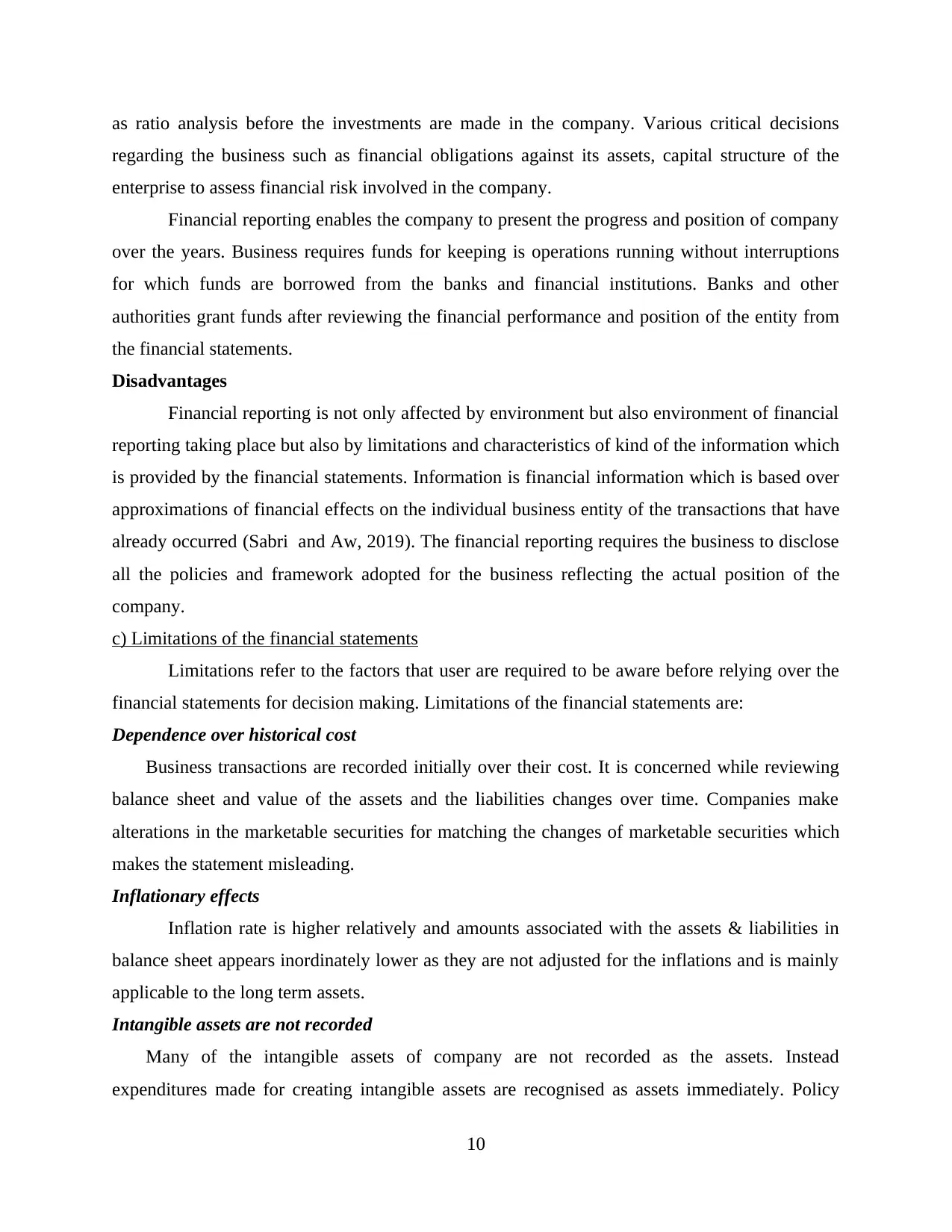
as ratio analysis before the investments are made in the company. Various critical decisions
regarding the business such as financial obligations against its assets, capital structure of the
enterprise to assess financial risk involved in the company.
Financial reporting enables the company to present the progress and position of company
over the years. Business requires funds for keeping is operations running without interruptions
for which funds are borrowed from the banks and financial institutions. Banks and other
authorities grant funds after reviewing the financial performance and position of the entity from
the financial statements.
Disadvantages
Financial reporting is not only affected by environment but also environment of financial
reporting taking place but also by limitations and characteristics of kind of the information which
is provided by the financial statements. Information is financial information which is based over
approximations of financial effects on the individual business entity of the transactions that have
already occurred (Sabri and Aw, 2019). The financial reporting requires the business to disclose
all the policies and framework adopted for the business reflecting the actual position of the
company.
c) Limitations of the financial statements
Limitations refer to the factors that user are required to be aware before relying over the
financial statements for decision making. Limitations of the financial statements are:
Dependence over historical cost
Business transactions are recorded initially over their cost. It is concerned while reviewing
balance sheet and value of the assets and the liabilities changes over time. Companies make
alterations in the marketable securities for matching the changes of marketable securities which
makes the statement misleading.
Inflationary effects
Inflation rate is higher relatively and amounts associated with the assets & liabilities in
balance sheet appears inordinately lower as they are not adjusted for the inflations and is mainly
applicable to the long term assets.
Intangible assets are not recorded
Many of the intangible assets of company are not recorded as the assets. Instead
expenditures made for creating intangible assets are recognised as assets immediately. Policy
10
regarding the business such as financial obligations against its assets, capital structure of the
enterprise to assess financial risk involved in the company.
Financial reporting enables the company to present the progress and position of company
over the years. Business requires funds for keeping is operations running without interruptions
for which funds are borrowed from the banks and financial institutions. Banks and other
authorities grant funds after reviewing the financial performance and position of the entity from
the financial statements.
Disadvantages
Financial reporting is not only affected by environment but also environment of financial
reporting taking place but also by limitations and characteristics of kind of the information which
is provided by the financial statements. Information is financial information which is based over
approximations of financial effects on the individual business entity of the transactions that have
already occurred (Sabri and Aw, 2019). The financial reporting requires the business to disclose
all the policies and framework adopted for the business reflecting the actual position of the
company.
c) Limitations of the financial statements
Limitations refer to the factors that user are required to be aware before relying over the
financial statements for decision making. Limitations of the financial statements are:
Dependence over historical cost
Business transactions are recorded initially over their cost. It is concerned while reviewing
balance sheet and value of the assets and the liabilities changes over time. Companies make
alterations in the marketable securities for matching the changes of marketable securities which
makes the statement misleading.
Inflationary effects
Inflation rate is higher relatively and amounts associated with the assets & liabilities in
balance sheet appears inordinately lower as they are not adjusted for the inflations and is mainly
applicable to the long term assets.
Intangible assets are not recorded
Many of the intangible assets of company are not recorded as the assets. Instead
expenditures made for creating intangible assets are recognised as assets immediately. Policy
10
⊘ This is a preview!⊘
Do you want full access?
Subscribe today to unlock all pages.

Trusted by 1+ million students worldwide
1 out of 14
Related Documents
Your All-in-One AI-Powered Toolkit for Academic Success.
+13062052269
info@desklib.com
Available 24*7 on WhatsApp / Email
![[object Object]](/_next/static/media/star-bottom.7253800d.svg)
Unlock your academic potential
Copyright © 2020–2025 A2Z Services. All Rights Reserved. Developed and managed by ZUCOL.





